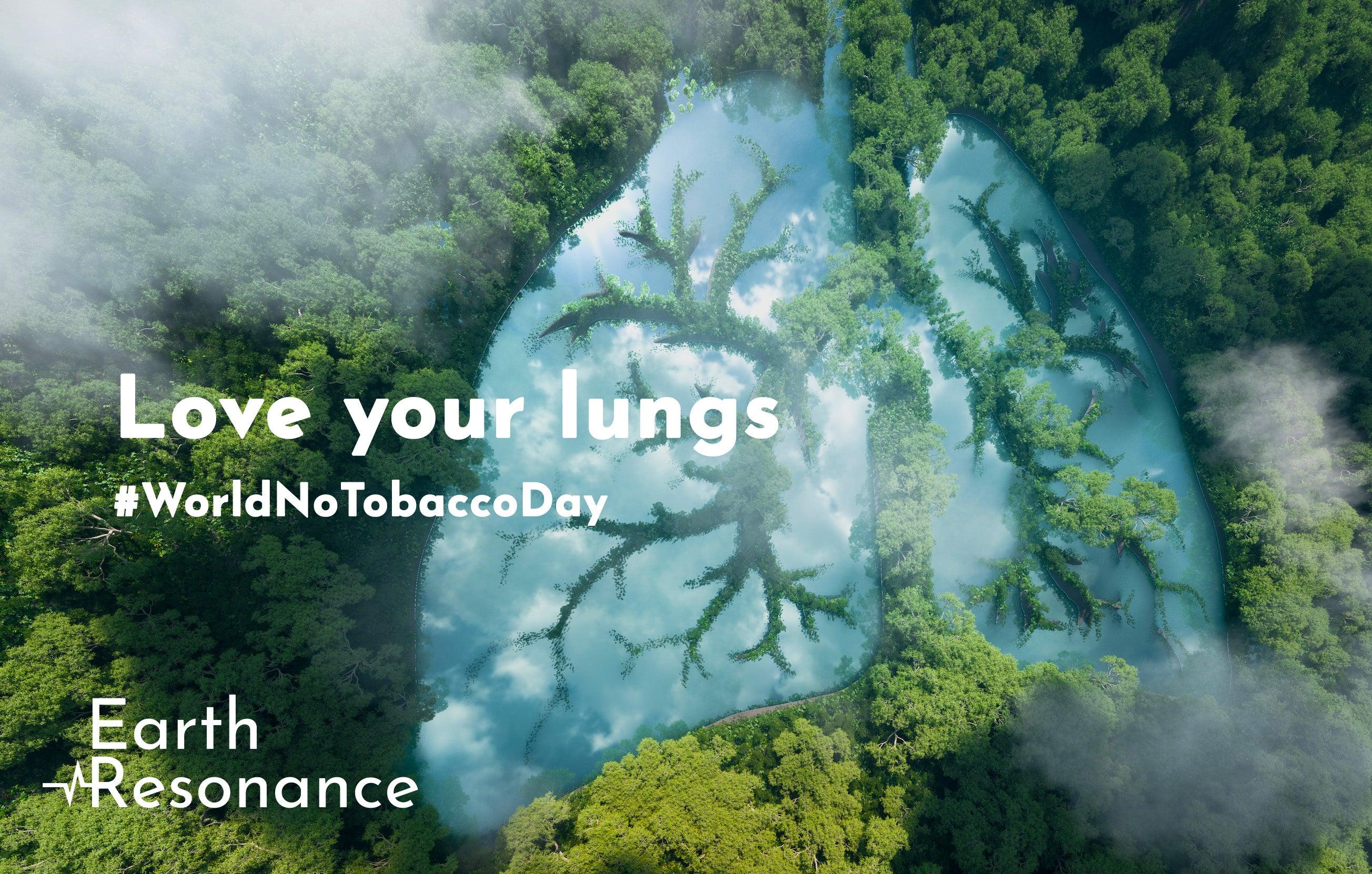It's World No Tobacco Day!
We all succumb to being disillusioned from time to time, be it a red-flag romance, a fad diet, or blatantly ignoring signs of a food allergy because it’s a food we love that much- despite it making us ill. However, it is time we wake up to the illusion of the tobacco industry. There is a global epidemic of nicotine dependence. This harmful addiction causes us to pollute not only our own lungs but the lungs of others around us, especially those closest to us.
Researchers all over the world are studying ways to stop tobacco and nicotine dependence. Take for example the following article published by Berkley News that discusses the scientific mechanisms underlying nicotine addictiveness in the brain, as well as the fact that most if not all of nic addicts experience sickness as a result of smoking. Researchers are currently designing methods to help eliminate nicotine dependence which include genetic editing technologies that would delete or create new receptors. What if we could intervene without dramatic pharmacological intervention?
Imagine if something a simple as Microdosing could help stop this global epidemic of nicotine dependence? Despite the overwhelming evidence, ongoing research and even publicity of the dangers of nicotine, people continue to smoke. The prevalence of smokers worldwide has declined, however smoking remains common throughout most countries of the world and nicotine dependence continues to haunt our health and our youth. There is reason to be concerned for the nic addicts of Generation Z who have now turned to e-cigarettes, which is harmful for reasons similar to cigarettes and also comes with its own risks. It’s safe to say, there’s no “safe” alternative to smoking cigarettes and there’s no healthy way to use nicotine.
Statistics and Interesting Facts
According to the WHO, tobacco kills more than 8 million people each year. Of those 8 million it is estimated that more than 1.2 million of those people die from indirect use, or second-hand smoke. There are more than 7,000 chemicals in cigarette smoke and over 70% of those chemicals are linked to cancer. Not all these chemicals are added during the manufacturing phase but some are naturally a part of the tobacco plant itself. Tobacco kills half of its users that do not quit smoking, giving all the more incentive to call it quits. E-cigarettes are not considered less harmful, as they are known to carry heavy metals, volatile organic compounds and other cancer-causing chemicals.
It is estimated that only 4% of users who try to quit are successful at quitting, indicating not only the level of nicotine addictiveness but also the reality that quitting smoking is an extremely difficult task.
History of Tobacco: By now it is rather well known that legal drugs such as caffeine, sugar, alcohol, and nicotine are incredibly profitable products serving the addictions of millions of people worldwide.
Tobacco should not be left behind when considering the reckless and morally questionable marketing tactics used by these common day industries.
While tobacco itself has origins in the indigenous cultures of north and south Americas, what we know as modern day cigarettes is incomparable from how it was smoked by the indigenous people.
Tobacco was initially derived from the leaves of a nightshade plant called, Nicotiana, hence nicotine, and it’s original use dates back to the Mayan people in Central America in the first century BC. It was later used by indigenous peoples for ritualistic uses and in ceremony. As colonization took place, the use and spread of tobacco increased. The modern usage of tobacco tends to be more impulsive and less ritualistic and cigarettes today are more harmful than the tobacco that was smoked in its original state.
Natural does not mean healthy:
While tobacco itself has many known toxic chemicals, manufactured cigarettes contain additional harmful substances that arise simply from the curing process. Curing tobacco is the process of drying the leaves to prepare them to be smoked, without curing the leaves smoking tobacco can be fatally dangerous due to high levels of nicotine and ammonia. All in all, whether the tobacco is natural or not, there are more than 7,000 chemicals found in cigarette smoke, and over 70% of those are linked to cancer.
Marketing in the Tobacco Industry
Perhaps the greatest 2 decades long marketing ploy of all times by the tobacco industry happened from the 1930s to 1950s, when physicians were recruited to test and approve cigarettes promising to the public that there was no health risk to smoking. Tobacco companies such as Camel’s cigarettes also forged false research studies to try to back their health claims used in their marketing, here is one such advertisement.

You can imagine the influence this had on the masses, especially in a time when people relied almost exclusively on conventional medical doctors for their health concerns.
Eventually science reversed its position on cigarettes and tobacco around the 1950s when research showing the link to cancer began to surface. By this time the tobacco industry was already embedded into culture, politics and the economy. There is now regulation concerning the tactics and health claims that tobacco companies are legally allowed to make, and each cigarette box comes with a warning label for the drug.
One such example includes the following image:
As you can see the imagery and wording is quite graphic, giving a much more accurate representation of the associated risks of smoking.
Despite the graphic warning labels, including warning of cancer and death, there exists an estimated 1.1 billion smokers worldwide, correlated with 7.7 million deaths annually. Some of the highest proportions of young adult smokers are in Europe and southeast Asia.
Is Smoking Really An Illusion?
After this brutal history of marketing deception by media, medical doctors and politicians alike, many laws have now been enacted to correct these errors. In 1970 President Nixon signed the Public Health Cigarette Smoking Act banning cigarette ads from the radio and television. And as of 2019 in the United States the minimum age to buy cigarettes was raised to 21 years old. Cigarette packs are now filled with graphic images of broiled lungs, rotting teeth, injured children, people coughing up blood and warning labels of cancer, heart and lung disease, the injury of children and death. Yet it was estimated in 2020 that 32% of adults around the world were cigarette smokers, causing roughly 7 million deaths per year. We may think we’ve woken up, but currently there exists an estimated 1.1 billion smokers worldwide.
Despite all of these warnings, statistics, lost and injured loved ones, why do we continue to light up a smoke? What is it about cigarettes that has us hooked to our dying breath and ignoring the injury of others and the planet in the process?
How Cigarettes impact the Body and Brain:
How does nicotine affect the brain? Nicotine enters the brain by passing the Blood Brain Barrier, it then acts as a neurotransmitter and stimulates the release of dopamine. As soon as nicotine is inhaled, it takes 10 seconds to enter the brain and have these effects. This characteristic of being so fast-acting contributes to the addictiveness of nicotine. Overtime the brain learns to adapt the effects of nicotine, building tolerance. This means that the more someone smokes, the greater the amount of nicotine is required to have the same effect on the individual.
Nicotine can also be considered a stressor as it causes adrenaline to be released from the adrenal glands. Adrenaline, also called epinephrine, is a hormone that stimulates the central nervous system and causes increased heart rate, blood pressure and rate of breathing. Nicotine is even passed on in the milk of breastfeeding mothers and will be passed onto the fetus inside the womb of a pregnant mother. Overtime, nicotine causes negative effects on the heart, lungs, kidneys, and reproductive system in addition to increasing the likelihood of developing cancers of the mouth and throat, stomach, esophagus, kidney, pancreas, liver, bladder, cervix, colon, rectum, pancreas, breast, and leukemia.
Why Nicotine is so Addictive:
How much nicotine is needed to get addicted? With so many reasons for people to stop smoking and so many people who continue to smoke, we confront the ever-pressing question: what makes nicotine so addictive? A drug’s level of addictiveness is determined by how reinforcing it is. Drug reinforcement is related to the dopamine released in the brain from a drug, and how this surge of dopamine causes someone to come back for more. Dopamine is a neurotransmitter involved in pleasure and reward and plays a significant role in addiction. For more information about drugs and addiction please refer to the following article, From Drug to Natural Medicine.
There are many reasons that nicotine is considered one of the most addictive drugs, even when compared to heroin and cocaine. One of those reasons is because as soon as someone inhales a cigarette, nicotine is immediately absorbed by the lungs and delivered to the brain stimulating instant release of dopamine. This surge of dopamine can be compared to an artificial reward, meaning that you are giving yourself an artificial feeling of “pleasure” which will eventually wear off. The addiction is not only coming from the brain and your subconscious desire for more pleasure, but the body also becomes dependent on the drug on a physiological level. This dependence causes physical illness when the drug is not received.
Although nicotine is known as a “mild” drug, it is important to remember that it is extremely addictive and it still has very detrimental health effects even if they are not as immediately obvious as other drugs.
Nicotine Withdrawal:
Nicotine withdrawal is very real, and can be extremely painful and uncomfortable, which is why it is important to do so with guided and experienced supervision. Nicotine affects all parts of the body including the heart, blood vessels, brain, hormones, and more. When you quit, you are depleting your body of substances that it has become accustomed to, and even dependent on! Common side effects of nicotine withdrawal include symptoms like irritability, outbursts of anger, and difficulty concentrating. Feelings of sadness, depression and anxiety are also common with nicotine withdrawal. It is also common to have difficulty sleeping, restlessness, loss of appetite, nausea, vomiting, headaches and difficulty resisting strong urges and cravings to smoke. As common as it is for people to start smoking without any health advice, it is often just as common for someone to try to quit without health advice or medical support. This is part of the reason for such low success rates when it comes to quitting smoking.
What you can do today to quit smoking:
How many days does it take to break a nicotine addiction?
Quitting Nicotine is not to be taken lightly. If you wish to quit, try to find support. Do what you can to build up a support system around you, not just one person but a few people close to you, trusted acquaintances, and even a coach, or a medical or health professional. Do not take it lightly just because it is a legal drug. It is very difficult to navigate the physical and emotional symptoms that you will face in this process. Make sure you are supported in your health by giving yourself ample time for rest, nourishment through foods and sunshine, and an accountability partner that will make it easier for you to stick to your commitment.
The initial withdrawal cycle will be the worst, lasting around 3-5 days. This is when the most painful physical symptoms occur, and it often feels like an actual sickness. After day 5 for most people the nicotine is cleared out of the system. From this point the most difficult task is to overcome the strong physical and mental urges to smoke. It is important to avoid triggers during this time, including stress, environments with a lot of smokers, or any environment where you would typically engage through smoking. This can be near impossible for many people to have control over, so even if you must be in these environments, try to be conscious about it. An example would be to take your accountability partner with you while you attend a social event who can help be a support.
Symptoms from quitting nicotine will last weeks after the last cigarette. It is common for people to feel mental symptoms of sadness, anxiety and depression when they quit smoking as the body is still working toward rebalancing back to its original state. Especially when these symptoms are experienced it is important to have a support system and a qualified guide who can help to ensure your safety and wellbeing.
If you are quitting nicotine, and either it’s your first time or you have tried before and failed- you are so brave for going through this journey! It is not easy, and it is an accomplishment. Give yourself time, and treat yourself well in this time, try to avoid being overly harsh or critical of yourself. If you are supporting someone close to you while they quit, please try to find yourself some support as well. It can be very difficult and draining to witness someone in this circumstance, and it wears on the entire household. Remember to give yourself and those around you a lot of grace through the process.
Can Microdosing help you stop smoking?
An increasing amount of research is being dedicated to study psychedelics for the treatment of drug addiction. Research has emerged indicating the potential of psilocybin in treating nicotine addiction suggesting that mystical experiences might be the explanation for psilocybin being one of the most promising outcomes of addiction treatment. The topic of mystical experiences is an important one when considering the effects of micro dosing psilocybin. A mystical experience eludes to the recognition of a higher force outside of oneself, when time and space seem to dissolve. It is often associate with “ego death” and seems to be an explanation for why these substances have potential when dealing with mental illness and disorders such as drug addiction.
Although micro dosing psilocybin will not emerge you into a full blown mystical experience, this element of mysticism is the nature of the medicine, and cannot go without recognition.
When considering micro dosing as a support system to quit smoking, multiple factors will be at play in helping you quit.
- Intention – before you start micro dosing to quit smoking, we recommend you work together with a coach, therapist, or health professional to help set your intention of why you wish to quit smoking, what you want to gain from quitting, and how you want to feel by the end of your session. I recommend gaining as much clarity as you can considering not only what you will gain when you quit, but also what you might lose and how it will impact you and those around you if you don’t quit. Try to ask yourself honestly what your vision is for your future and if smoking is something that brings you deep fulfillment?
- Mysticism - The mushrooms work their magic even with a low dose. With the micro dosing approach you can expect more subtle hints of subconscious messages coming your way. This can be interpreted as your intuition, or downloads, but it’s likely that you will feel more attuned to a power greater than you, and more attuned to the higher power within you! This is the magic.
- Subconscious reprogramming – As micro dosing creates an environment of neuroplasticity in the brain, you will have the opportunity to introduce new beliefs and new habits that you prefer to carry with you in your life. This gives you the opportunity to leave smoking behind, along with the belief systems that come with it. Don’t expect any of this to happen overnight, the mushrooms only provide the right environment- you still must do the work. This is currently the best explanation for why psilocybin can be so effective with treating drug addiction. As stated by the researchers on the John’s Hopkins team, psilocybin may help break the addictive pattern of thoughts and behaviors that have become ingrained after years of smoking. Therefore, it is essential to keep your thoughts and beliefs at the focus during this process- the more patterns you can confront during your micro dosing session, the better.
Researchers at John’s Hopkins carried out a fascinating study in which participants were given psilocybin in a controlled setting, with mental health professionals. The results of the study were phenomenal with over 80% of smokers being cigarette and nicotine free 6 months after the study ended. These were individuals who had been smoking cigarettes for an average of 31 years and who had previously tried to quit smoking before without success. This is quite substantial when considering other more conventional treatment options have a success rate of less than 30-35%.
Smoking just isn’t sexy. While many might associate the act of smoking to rockstars, Hollywood actors, and even dreamy romance scenes in Paris, the associations cigarettes have of being anything other than harmful, life threatening and invasive need to change, immediately! Micro dosing is showing extremely promising results when it comes to helping people quit their addiction to nicotine. Perhaps it can help transform our entire world view toward nicotine addiction. Research suggests that the primary way in which psilocybin might be successful in treating nicotine addiction is the way in which it transforms our underlying belief system. The mushrooms are teaching us, once again, our beliefs and our thoughts really matter. Once we work on those, we can watch the world around us transform.
Article written by Elise Renn





